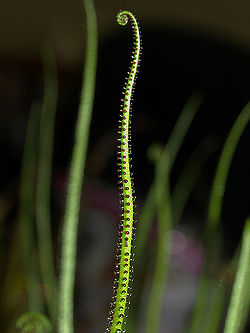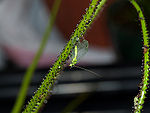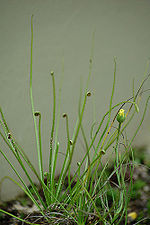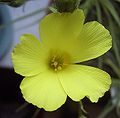Dewy pine
| Dewy pine |
|---|
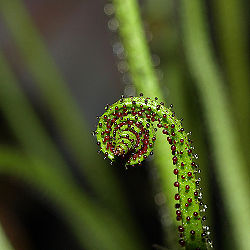
|
| Scientific Classification |
|
| Binomial Name |
|
Drosophyllum lusitanicum |
| Image Description |
The Dewy Pine is a species of carnivorous plant known by the scientific name Drosophyllum lusitanicum This killer plant lives in hash conditions and is always covered in slimy glop that attract unsuspecting prey. In its native land, Portugal, it is called the “ Pinheiro baboso” which means “slobbering” Pine or also known elsewhere as the Portuguese Sundew. The people of southern Spain in the Alcala de los Gazules region call it “La Gazul”. This meat-eater keeps its home at dry coastal regions where there is an abundance of food and sun. Its long thin leaves will curl up when a fly lands on it to digest the trapped food.
Anatomy
The Dewy pine is a carnivorous plant that resembles a common shrub or pine (hence the American common name, Dewy pine) this meat eater can grow to be up to 1.5 m in height. The average height for this plant though, is around 40 cm high. The stem itself can be 5-15 mm thick, as the stem grows to be larger; it tends to creep and spread out on to the ground surrounding it. The leafs on the Dewy pine are narrow, triangular leaves that are very distinct and important to the survival of the plant.[1] Sticky droplet filled leaves can grow to be a height of 10-25 cm with a width of 2.5 mm. The plant begins to bud and flowering occurs between February and May, and some times in June but rarely. Flowers that spout out of this killer plant are beautiful bright yellow, regular; quinate flowers can grow to be up to 4 cm in diameter. The flowers very rarely grow separately; instead they are clumped together in groups of 3 - 15.
The Dewy Pine is a plant that has interested scientists and botanists for a while. The unique thing about this plant is that out of all the rest of the carnivorous plants in the world such as the Pitcher Plant, Venus Fly Trap, etc., this meat eater is the most successful in trapping plants when it comes to quantity. The plant is able to capture several bugs on each of its leaf-stalked clammy glands. The prey count is so numerous that the plant has a passive primitive adhesive trap, that is less aggressive.[2]
Another interesting facet is the classification of the plant. It has been classified as the Drosophyllum, because of its distinct morphological and anatomical curiosities, which include missing specific dividing coir - cambium (an endodermis in the stem), characteristic surface of stem, shape of leaves, and spirally twisted ends of leaves, leading to the belief that the Dewy pine may be closely related to the fern classification.[3]
Drosophyllum is also interesting in that it has two types of glands on the leaves that are vital to its survival. There are the huge stalked glands that attract and trap prey for the plant to digest. There are also the sessile, digestive glands (Juniper et al., 1989). The plant produces so much of the stalked glands, the mucilage for trapping prey that the leaf is covered in the sticky slime. Because of this the plant can have clear sap-looking liquid dripping off of its leaves. When the lured insects land on the leaves, they find themselves stuck in the sweet smelling mucilage secreted by the stalked glands on the leaves. The bug will try to fly free, but unfortunately the more the insects struggle, the more ensnared they become, ultimately dying of suffocation or exhaustion.
The plant then secretes enzymes which dissolve the insects and release the nutrients which are then absorbed by the plant. The plant uses these nutrients to supplement the nutrient-poor soil it grows in. After the prey is caught it is digested. The process of digestion is very rapid, being complete within several days of being captured. The plant is able to capture more than enough prey to extract enough nutrients to survive by its luring process. The plant can lure in bugs and flies by its sweet, honey-like odor of the mucilage, this strong smelling scent is so dense that the mucilage trapping smell is detectable even by the human nose.[4]
Reproduction
Drosophyllum lusitanicum reproduces much like all other plant. The plant will produce seed from the flower and will begin the reproduction cycle of the flower once the plant has reached the maturity point of its life. When the plant is in hostile conditions, near the coastlines and in poor soil, it will usually reproduce asexually.
Ecology
The Drosophyllum plant originates from the counties Portugal, Spain, Morocco and the surrounding areas, but it is scarce in its native land of Portuguese. This plant lives in these regions near the cost line because, much like all carnivorous plants, it needs a major amount of sun to survive. The average sun intake that the flower needs is around half a day of direct sun each day. The plant also is grows best in acidic soil, with a ratio of 5-2-1 (5 peat moss: 2 perlite: 1 horticultural charcoal). The sundew is a plant that is not very picky in what type of soil it is planted in. it does not require rich soil full of nutrients or vitamins. They are mostly found sprouting out of loose over growth filled with sand and lacking lime. The plant is able to survive in these conditions and depleted soil because, whatever it cannot obtain through its roots or the soil, it obtains from the prey it catches and digests. [5] Because the Drosophyllum comes from a Mediterranean climate, the plant will grow the best in the seasons of fall, winter and spring months. Warm days (65-75 F) and cool nights (50 F) are the ideal temperatures for this plant. [6]
Other
Gallery
References
- The Portuguese Sundew (Drosophyllum lusitanicum) in nature and cultivation Jan Flísek & Kamil Pásek. BestCarnivorousPlants.com
- Drosophyllum lusitanicum Jan Flísek & Kamil Pásek, Ecology & Evolutionary Biology Greenhouses, University of Connecticut.
